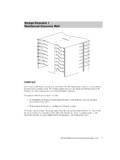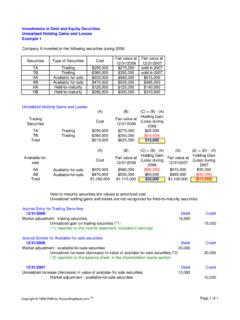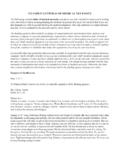Transcription of EXAMPLE 1. NOT EQUALS SHORTCUT - SAS Support
1 Paper 7540-2016 PROC SQL for SQL Die-hards Barbara Ross, Subprime & Underbanked Analytics Association LLC; Mary Jessica Bennett, Snap Finance ABSTRACT Inspired by Christianna William s paper on transitioning to PROC SQL from the DATA step, this paper aims to help SQL programmers transition to SAS by using PROC SQL. SAS adapted the Structured Query Language (SQL) by means of PROC SQL back with Version 6. PROC SQL syntax closely resembles SQL, however, there some SQL features that are not available in SAS. Throughout this paper, we will outline common SQL tasks and how they might differ in PROC SQL; as well as introduce useful SAS features that are not available in SQL.
2 Topics covered are appropriate for novice SAS users. INTRODUCTION Transitioning from a SQL shop to a SAS shop, or vice versa, can be a challenging experience. Most SQL die-hards believe the PROC SQL procedure will be a life-saver. That is, until they realize that minor syntax differences between the two can turn into a major nuance. Contrary to what a SQL die-hard visualized, most of the time they will not be able to copy and paste SQL code into SAS by means of PROC SQL. In this paper, we outline a few of the issues that we, as programmers, encountered when deemed with the task of transforming SQL logic into SAS code. This list is not all encompassing, but includes some of the key issues we have been faced with while making the transition.
3 EXAMPLE 1. NOT EQUALS SHORTCUT One small change between SAS and SQL is the SHORTCUT notation for not EQUALS . In SQL, you can type != and <> . This notation is not recognized in SAS, you must use ^= . In both systems you can type out NOT EQUAL as well. SQL Code: SELECT * FROM inputds WHERE date_created != '2014-01-05'; SAS Code: SELECT * FROM inputds WHERE date_created ^= '05jan2014'd; EXAMPLE 2. CONCATENATING STRINGS With MSSQL, a plus sign, + , can be used to concatenate strings. Similarly in SAS, one can use double pipes, || . Outside of the notations, there several functions to concatenate strings as well. The SAS CAT and SQL CONCAT functions are very similar and both work like the + and || notations.
4 SAS also has variations on the CAT function that automatically trim leading and trailing blanks, removing the need to use RIGHT/LEFT/TRIM functions. Popular SAS concatenation functions include: CATX (removes trailing and leading blanks and inserts delimiters), CATT (removes trailing blanks), and CATS (removes trailing and leading blanks). MSSQL Code + & CONCAT: SELECT FirstName + ' ' + LastName As FullName ,CONCAT(FirstName,' ',LastName) as FullName2 FROM Customers; MySQL Code CONCAT: SELECT CONCAT(FirstName,' ', LastName) As FullName PROC SQL for SQL diehards , continued 2 FROM Customers; SAS Code - || & CATX: SELECT FirstName || ' ' || LastName As FullName ,CATX(' ',FirstName,LastName) As FullName2 FROM Customers; EXAMPLE 3.
5 SELECTING N OBSERVATIONS When exploring a new database, it is often helpful to be able to select a limited number of records from a dataset. With SAS, you will use the OUTOBS= statement to limit the number of records shown. The equivalent in MSSQL is the TOP statement, and MySQL uses the LIMIT statement. MSSQL Code: SELECT TOP 10 * FROM inputds_201411; MySQL Code: SELECT * FROM inputds_201411 LIMIT 10; SAS Code: PROC SQL OUTOBS=10; CREATE TABLE tmp AS SELECT * FROM inputds_201411; QUIT; EXAMPLE 4. VARIABLE NAME LENGTH It s worth noting that SAS is much more conservative than SQL when it comes to naming variables. If you are accessing a SQL database through a SAS libname, SAS will crop/rename your variable names to conform to their naming conventions.
6 Allowed variable name lengths: SAS - 32 characters Oracle - 30 characters MSSQL - 128 characters (116 characters in temporary tables) MySQL 64 characters Also SAS does not Support variable names that start with a number. In SQL, you can t declare a name beginning with numbers, but you can rename them to. When accessing that table in SAS, SAS will prefix the name with an underscore ( 2paydefault renamed to _2paydefault ). SQL allows for variable names with spaces as well. SAS Enterprise Guide (EG) also allows spaces, so these variables will not be renamed when accessing your SQL tables through SAS EG. However, it is difficult to reference variables with spaces in their names.
7 To have SAS rename variables names without spaces, you can use the system option VALIDVARNAME. Setting this to v7 will replace the spaces in the variable names with underscores ( _ ) making them easier to work with in SAS. SAS OPTIONS VALIDVARNAME=v7; EXAMPLE 5. DATA TYPES SQL has over 30 different data types that can be used when defining variables. SAS only has 2 data types, character and numeric (dates are numeric). So during your conversion, you will need edit any code that CASTs or CONVERTs your data to types not available in SAS ( varchar, integer, decimal, float). SQL Code: PROC SQL for SQL diehards , continued 3 SELECT CAST(Ndefaulted as float)/Nloans AS Default_Rate FROM inputds; SAS Code: SELECT Ndefaulted/Nloans AS Default_Rate FORMAT= FROM inputds; QUIT; To control how data is displayed, SAS assigns formats to each variables.
8 There are hundreds of ready-to-use formats, but SAS also allows programmers to create their own. Custom formats can also be used to recode values as an alternative to CASE WHEN statements. It s important to note that formats do not change the actual value of the data. If you want to permanently change a value, the format will need to be applied to a variable using the PUT function. The EXAMPLE below shows how a format can be used to change a value in SAS, replacing the CASE WHEN statement. SQL Code: SELECT CASE WHEN x='T' THEN 'True' WHEN x='F' THEN 'False' ELSE NULL END as NewX ,CASE WHEN x2='T' THEN 'True' WHEN x2='F' THEN 'False' ELSE NULL END as NewX2 FROM inputds; SAS Code Format in place of CASE/WHEN: PROC FORMAT; VALUE $tf 'T'='True' 'F'='False' other=''; RUN; PROC SQL; SELECT PUT(x,$tf.)
9 As NewX ,PUT(x2,$tf.) as NewX2 FROM inputds; QUIT; To control storage allotted, in SAS each variable is associated with a length. Lengths are automatically assigned by SAS unless explicitly defined before the data is read. They are set to the length of the first record read in. For EXAMPLE , if the first record in your data set has a value of No , SAS will set the length of that variable to 2. If the next record is Yes , SAS will truncate that record to have a length of 2, therefore keeping Ye . A nice thing about PROC SQL is that SAS will set the length of a new variable created by CASE WHEN to the longest length possible by the statement ( CASE WHEN 1 THEN No ELSE Yes END will have a length of 3).
10 Working together, the data type, length, and format are what defines how a variable is treated, stored and displayed (respectively) in SAS. If you want to know more about SAS lengths and formats or SQL data types and implicit conversions, there are a few links referenced in the recommended reading section. EXAMPLE 6. CONVERTING NUMERIC TO CHARACTER To convert a variable to a different data type, SQL has the CONVERT and CAST functions. SAS does not Support CONVERT/CAST rather you must use the PUT and INPUT functions. The PUT function applies a format to a value, which allows it to convert a numeric value to a character field. INPUT reads in a value based on an informat, which allows you to read in a character field as numeric (Just remember IN for INput and INformat!)
















